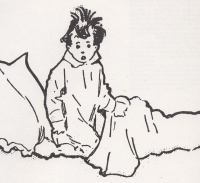Children's literature
From The Art and Popular Culture Encyclopedia
|
"In England the bulk of children's writing concentrated on Aesop's fables rather than La Fontaine's adaptations. The boundary lines began to be blurred in compilations that mixed Aesop's fables with those from other sources. The middle section of "Modern Fables" in Robert Dodsley's Select Fables of Esop and other fabulists (1764) contains many from La Fontaine. These are in prose but Charles Denis' earlier collection was in verse and several authors writing poems specifically for children in the early 19th century also included versions of La Fontaine. Although there had been earlier complete translations in verse at the start of that century, the most popular was Elizur Wright's The Fables of La Fontaine, first published in Boston in 1841 with prints by Grandville. This went through several editions, both in the USA and in Britain. Other children's editions, in both prose and verse, were published in the 20th century."--Sholem Stein |

Illustration: Little Nemo sitting upright in bed
|
Related e |
|
Featured: |
Children's literature is a literary genre whose primary audience is children, although many books within the genre are also enjoyed by adults.
History
Early children's literature consisted of spoken stories, songs, and poems, that would have been used to educate, instruct, and entertain children. It was only in the 18th century, with the development of the concept of "childhood", that a separate genre of children's literature began to emerge, with its own divisions, expectations, and canon.
French historian Philippe Ariès argued in his 1962 book Centuries of Childhood that the modern concept of "childhood" only emerged in recent times, and that for the greater part of history, children were not viewed as greatly different from adults, and were not given significantly different treatment. As evidence for this position, he noted that, apart from instructional and didactic texts for children written by clerics like the Venerable Bede, and Ælfric of Eynsham, there was a lack of any genuine literature aimed specifically at children before the 18th century.
Other scholars have qualified this viewpoint by noting that there was a literature designed to convey the values, attitudes, and information necessary for children within their cultures, such as the Play of Daniel from the 1100s. Pre-modern children's literature, therefore, tended to be of a didactic and moralistic nature, with the purpose of conveying conduct-related, educational and religious lessons.
See also
- Book talk
- Children's literature canon
- Children's literature criticism
- Children's literature timeline
- International Children's Digital Library
- Native Americans in children's literature
- Young-adult literature
Lists
- List of children's classic books
- List of children's literature authors
- List of children's non-fiction writers
- List of fairy tales
- List of illustrators
- List of publishers of children's books

